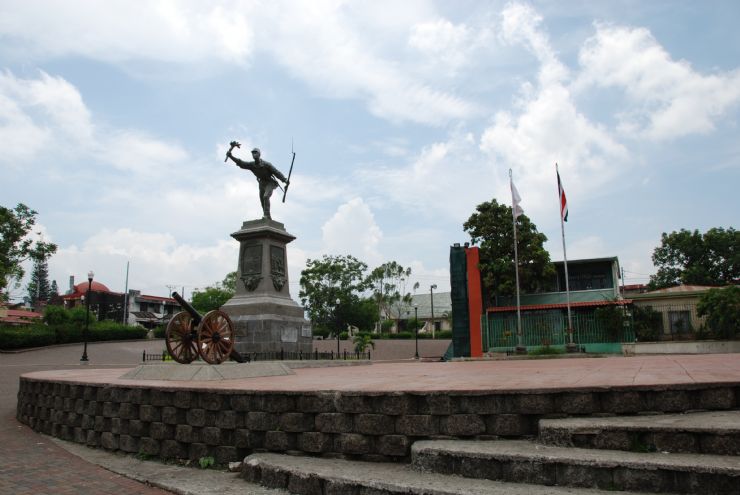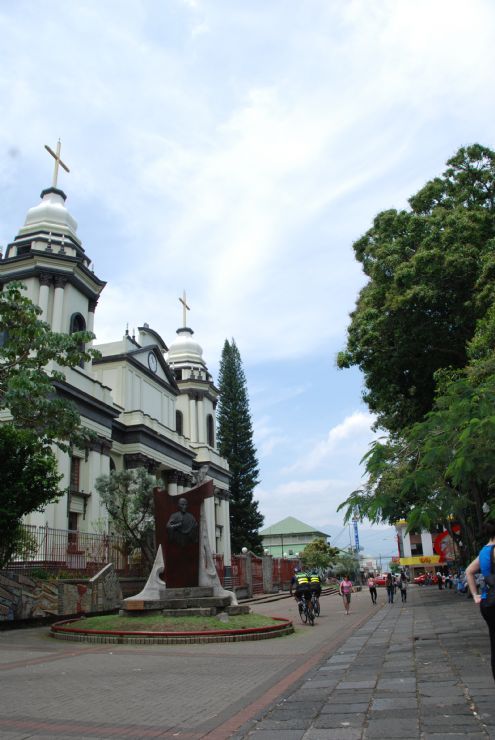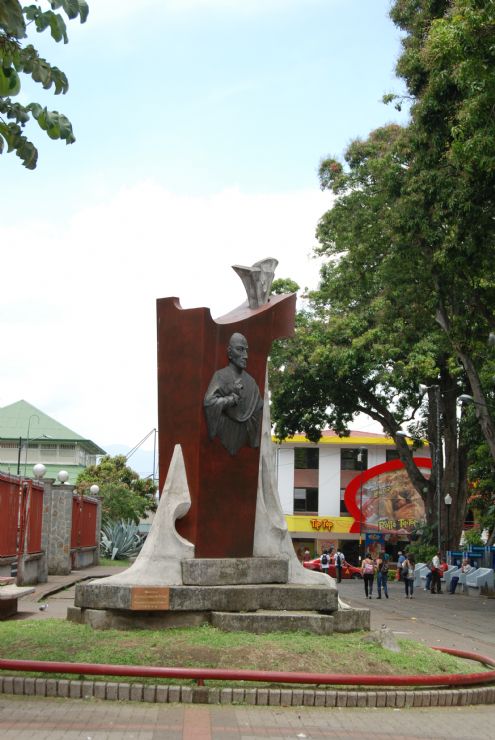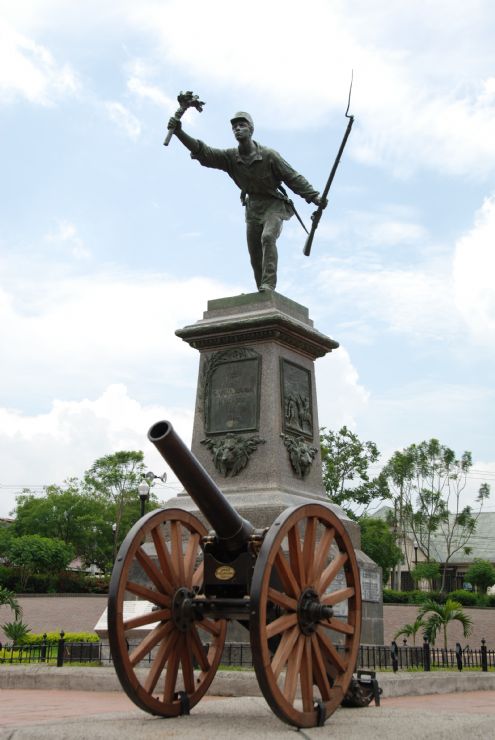
Costa Rica National Hero Juan Santamaria
If you visit Costa Rica, you might see one name over and over again: Juan Santamaría. It’s hard to miss his name on a statue in an Alajuela park, as well as on San José in front of the congress, on the museum in San José, and, of course, many of the visitors to Costa Rica fly into an airport bearing his name. If you happen to be hopping around in Costa Rica on April 11th of any given year, you’ll also notice that the entire country, including this frog, is celebrating Juan Santamaría on that day. But what is it that makes this man a legend in Costa Rica?
The short story is that Juan Santamaría is one of my country’s most beloved national heroes. The longer story is one of patriotism, courage, and strength – and it all happened some 50 years AFTER Juan died. Sounds crazy, right? Well Costa Rica has always been a country of rich history, and has never been shy about remembering and honoring it.

The Cathedral in Alajuela
A Hero’s Humble Beginnings
Like many heroes from many countries, Juan Santamaría had humble beginnings. Not much is known of his earliest years of life, since most of the focus on him revolved around his years as a soldier. What we do know definitively is that he was born on August 29 ,1831, in Alajuela. While in truth his early years are a mystery, much is known about my country, in general, from that time. It’s easy to deduce that a young boy born in this area of Costa Rica would have had a rural childhood as a farmer. He likely worked on a coffee plantation, growing and harvesting the crops that remain one of Costa Rica’s main economic contributions.
7 Days / 6 Nights
Starting at $779 per person
It was in Juan Santamaría’s 25th year of life that he sacrificed his life for his country. This legendary bravery, though critical to the success of the turning point of a violent conflict, went largely uncelebrated for nearly 50 years. It was during a political campaign that a long dead Juan Santamaría was thrust into the spotlight. As a tactic to associate national pride with his name, one presidential candidate evoked the name of this fallen soldier. The campaign was wildly successful, and so the Costa Rica government set out to find out more about the history of this man that helped rally the country.

Commemorative Statue next to the Cathedral in Alajuela
A History of Heroism
The problem with researching a man that had already been dead for nearly 50 years was that most of the people that knew him were dead too. The official records from the time around the 1850´s weren’t helpful either, as they were mostly non existent. Luckily, his heroics on the battlefield were documented enough that a clear story is available. This is the story that children learn in school; the story that is celebrated by the people of Costa Rica each year; the story that is told over and over again at one of Juan Santamaría’s many dedicational landmarks. The scene is not good. An American man named William Walker, a filibuster, gained power and attempted to overthrow several Central American nations, including my wonderful home. To aid in defeating being conquered, the president of Costa Rica at the time, Juan Rafael Mora Porras called for the men of his country to bear arms to resist the sizeable and intimidating forces of William Walker.
The militia was able to defeat a small group of the invaders at Santa Rosa in Guanacaste, and their spirits were high as they continued marching north to meet another battle. When they reached Rivas, in Nicaragua, though, they faced a more formidable enemy. They arrived on April 8th in 1956, and began what is now known as the Second Battle of Rivas. The area was heavily occupied by Walker’s men, centered at a hostel, and the Costa Rican soldiers were not able to repeat the success that they had in Santa Rosa. They knew that they had to drive Walker’s men out of the hostel that they held, since it gave the enemy an advantageous firing position. As the story goes, after a few unsuccessful days, the Costa Rican camp, led by General Jose Maria Cañas, decided that their tactical plan was to burn down the hostel. Several brave soldiers attempted this plan, but were killed before they could complete their mission. Juan Santamaría was the last soldier to volunteer. As he forged forward to his mission, he was mortally wounded by enemy fire; however, this did not stop him. He was able to light the hostel on fire before he died.
This feat, which seems like a small point in time during a bigger battle, is actually considered the turning point of the conflict – a conflict in which Costa Rica came out the victors by defeating Walker. While there are some historians that do not believe in the accuracy of this account, it is the one that is widely accepted and that has documentation that satisfied the government enough to support it.

Monument of Hero Juan Santamaria
A Celebration of Life
So, that is the story of Juan Santamaría, and I’m sticking to it. And now, every year, even 150+ years later, on April 11th, I gather with the people of my country on the anniversary of his death to celebrate the life that he lived, the sacrifice that he made, and the lives that he saved through his patriotism, courage, and strength. I hope that one day you’ll fly into the Juan Santamaría International Airport in Costa Rica and think about this hero and his contribution to this great country that is here in its pure state for everyone to enjoy. For the people of Costa Rica, Juan Santamaría isn’t just a story, a statue, or an airport; to us, he is a legacy that lives forever in our hearts and minds. If you ever find yourself in Alajuela, his birthplace, you can honor his heroism by visiting the statue that is dedicated to him.

